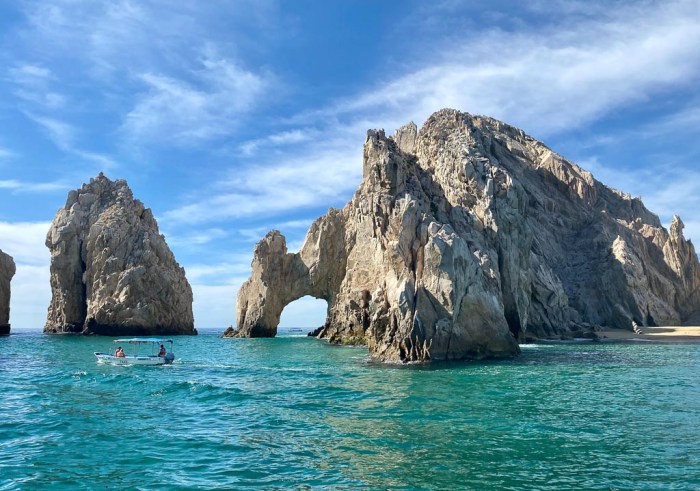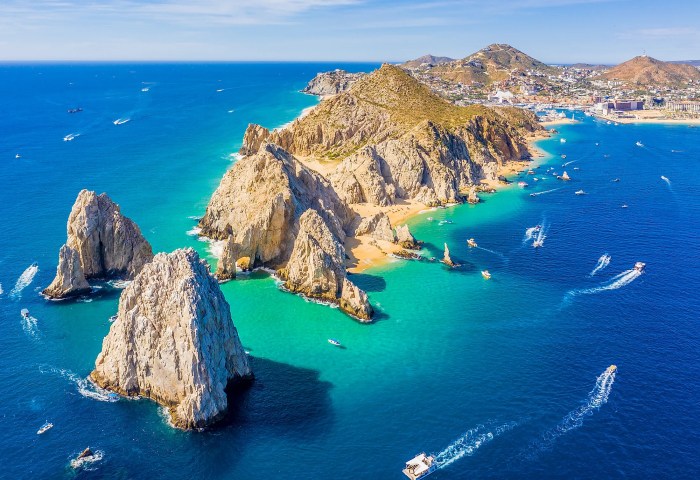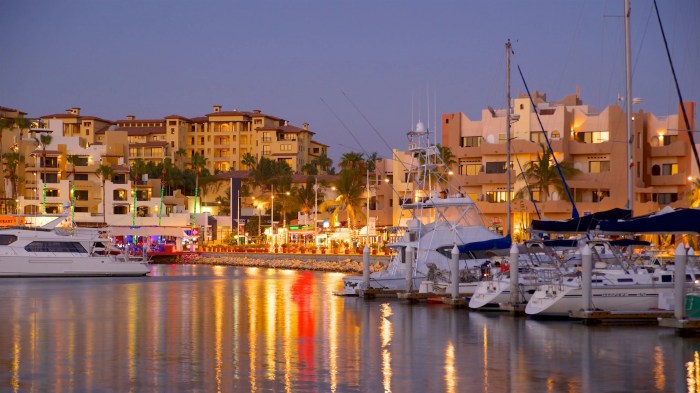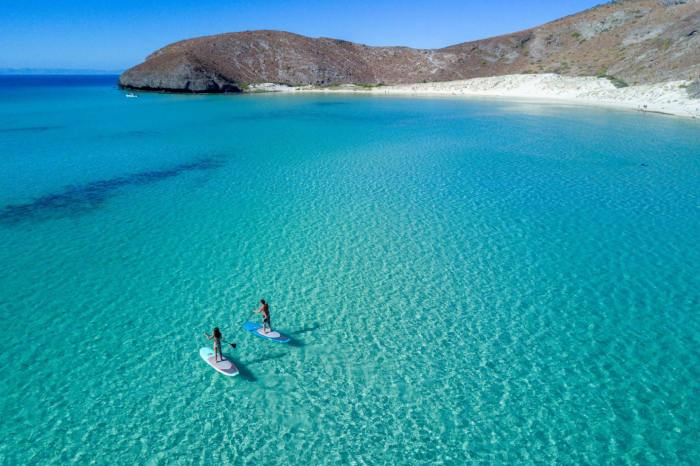Baja California Sur, a peninsula cradled by the Pacific Ocean and the Gulf of California, unveils a captivating narrative that intertwines unique geography, rich biodiversity, intriguing history, vibrant culture, and a thriving tourism industry. This captivating land beckons travelers and nature enthusiasts alike, offering an unforgettable symphony of experiences.
From its rugged deserts to its majestic mountains and pristine coastlines, Baja California Sur’s diverse landscapes paint a breathtaking canvas. Its strategic location has shaped its climate and ecosystems, creating a haven for an astonishing array of flora and fauna. The region’s history is a tapestry woven with threads of indigenous cultures, colonial influences, and modern-day advancements, leaving a legacy of captivating traditions and cultural expressions.
Baja California Sur’s Unique Geography
Baja California Sur boasts a captivating tapestry of geographical features, from vast deserts to towering mountains and pristine coastlines. Its unique location at the southern tip of the Baja California Peninsula, sandwiched between the Pacific Ocean and the Gulf of California, has profoundly shaped its climate and ecosystems.
Deserts
The interior of Baja California Sur is dominated by arid deserts, including the Vizcaíno Desert and the Magdalena Desert. These deserts are characterized by sparse vegetation, scorching temperatures, and limited rainfall. The landscape is dotted with towering cacti, ocotillo plants, and creosote bushes, all adapted to survive in the harsh conditions.
Baja California Sur, a peninsula in Mexico, boasts stunning beaches and desert landscapes. Its rich culture and history are reflected in its charming towns and traditional cuisine. For a taste of the urban side of Mexico, venture to Astor Place in Mexico City, a vibrant neighborhood known for its eclectic mix of restaurants, bars, and art galleries.
Upon returning to Baja California Sur, you’ll appreciate its tranquility and natural beauty even more.
Mountains
Contrasting the flat deserts, Baja California Sur is also home to a series of rugged mountain ranges. The Sierra de la Giganta, located in the central part of the peninsula, is the most prominent range, with peaks reaching over 10,000 feet. These mountains provide a dramatic backdrop to the surrounding desert and coastal landscapes, creating a diverse and awe-inspiring topography.
Coastlines
The coastline of Baja California Sur is equally captivating, with long stretches of pristine beaches, towering cliffs, and secluded coves. The Pacific coast is known for its crashing waves and rugged beauty, while the Gulf of California coast is characterized by calm waters and abundant marine life. The coastline is a haven for surfers, swimmers, and snorkelers, offering a range of water-based activities.
Impact of Geographical Location
Baja California Sur’s unique geographical location has a profound impact on its climate and ecosystems. The peninsula’s proximity to the Pacific Ocean moderates temperatures, while the Sierra de la Giganta range acts as a barrier to moisture from the east, creating a rain shadow effect that contributes to the arid conditions of the interior. This diverse geography has resulted in a rich and unique array of flora and fauna, including endemic species found nowhere else on Earth.
Baja California Sur’s Biodiversity

Baja California Sur is a biodiversity hotspot, home to a wide variety of plant and animal life. This diversity is due to several factors, including the peninsula’s unique geography, climate, and isolation from the mainland.
Flora
The flora of Baja California Sur is characterized by a mix of desert, scrubland, and forest ecosystems. The desert regions are home to a variety of cacti, succulents, and other drought-tolerant plants. The scrublands are dominated by shrubs and small trees, while the forests are home to a variety of coniferous and broadleaf trees.
- Over 2,000 plant species, including 600 endemic species
- Diverse desert flora, including giant cardon cacti and boojum trees
- Unique island ecosystems with endemic plants, such as the Magdalena Island rose mallow
Fauna
The fauna of Baja California Sur is equally diverse, with over 1,000 species of vertebrates and invertebrates. The peninsula is home to a variety of marine mammals, including whales, dolphins, and sea lions. The land-based fauna includes a variety of reptiles, amphibians, birds, and mammals.
- Over 1,000 vertebrate species, including 90 endemic species
- Important breeding grounds for marine mammals, such as gray whales and sea turtles
- Endemic bird species, such as the Baja California Thrasher and Xantus’s Hummingbird
Conservation
The biodiversity of Baja California Sur is under threat from a variety of human activities, including habitat loss, pollution, and climate change. Conservation efforts are underway to protect the peninsula’s ecosystems and wildlife. These efforts include the establishment of protected areas, the implementation of sustainable land management practices, and the education of local communities about the importance of conservation.
- Establishment of protected areas, such as the Vizcaino Biosphere Reserve and the El Vizcaino Desert
- Sustainable land management practices to reduce habitat loss and fragmentation
- Education and outreach programs to raise awareness about conservation issues
Baja California Sur’s History and Culture

Baja California Sur’s history is a rich tapestry woven from the threads of indigenous, Spanish, and Mexican cultures. Its unique geographical location has shaped its cultural identity, resulting in a blend of traditions and customs that set it apart from the rest of Mexico.
Indigenous Roots
Before the arrival of Europeans, Baja California Sur was inhabited by indigenous tribes such as the Pericúes, Guaicuras, and Cochimíes. These groups lived in harmony with the land, subsisting on fishing, hunting, and gathering. Their spiritual beliefs and practices centered around nature and the elements.
Spanish Influence
In the 16th century, Spanish explorers arrived in Baja California Sur. They established missions and settlements, introducing Christianity and European customs to the region. The Spanish influence is evident in the region’s architecture, language, and religious practices.
Mexican Independence
Baja California Sur became part of Mexico after the country gained independence in 1821. However, it remained relatively isolated from the rest of the country until the 20th century. This isolation allowed for the preservation of many indigenous traditions and customs.
Modern Baja California Sur
In recent decades, Baja California Sur has experienced significant economic growth due to tourism and agriculture. This has led to an influx of people from other parts of Mexico and abroad. As a result, the region’s cultural landscape is becoming increasingly diverse.
Cultural Expressions
Baja California Sur is renowned for its vibrant cultural expressions. Its music, art, and cuisine reflect the region’s unique blend of indigenous, Spanish, and Mexican influences.
Music, Baja california sur
Baja California Sur’s music is a lively fusion of traditional Mexican rhythms and instruments with indigenous influences. The region is home to several popular music genres, including banda, norteño, and ranchera.
Art
The art of Baja California Sur is inspired by the region’s natural beauty and indigenous heritage. Artists often use bright colors and bold patterns to depict scenes of everyday life, landscapes, and traditional symbols.
Baja California Sur, located on the Pacific coast of Mexico, is renowned for its stunning landscapes and diverse marine life. For an unforgettable underwater experience, consider visiting the aquarium sydney , home to a vast array of marine creatures from around the globe.
After exploring the depths of the ocean at the aquarium, return to Baja California Sur to immerse yourself in its pristine waters and encounter its vibrant marine ecosystems.
Cuisine
Baja California Sur’s cuisine is a culinary delight. It features fresh seafood, local produce, and traditional Mexican flavors. The region is known for its delicious seafood dishes, such as fish tacos, ceviche, and grilled lobster.
Baja California Sur’s Tourism Industry

Baja California Sur is renowned for its captivating natural beauty, boasting pristine beaches, crystal-clear waters, and a unique desert landscape. These attractions have made it a popular tourist destination, drawing visitors from around the world.
The region’s rich marine ecosystem is a major draw for tourists. The Sea of Cortez, also known as the “Aquarium of the World,” is home to an abundance of marine life, including dolphins, whales, and sea turtles. Snorkeling, diving, and whale watching are popular activities in the area.
Another major attraction is the Sierra de la Giganta mountain range, which offers stunning hiking trails and breathtaking views of the desert landscape. The mountains are home to a variety of plant and animal species, including the endemic boojum tree and the peninsular bighorn sheep.
Economic and Environmental Impacts of Tourism
The tourism industry has had a significant economic impact on Baja California Sur. It is a major source of employment and revenue for the region, supporting local businesses and infrastructure development. However, the industry has also raised concerns about environmental sustainability.
The influx of tourists can put a strain on the region’s natural resources, such as water and energy. Additionally, the construction of tourist facilities can damage fragile ecosystems. To address these concerns, the government and tourism industry are working together to promote sustainable practices and protect the environment.
Baja California Sur’s Economic Development

Baja California Sur has experienced significant economic growth in recent years, primarily driven by tourism and real estate development. The region’s unique natural beauty and warm climate have made it a popular destination for both domestic and international visitors, leading to a surge in hotel construction and other tourism-related infrastructure.
Baja California Sur is a beautiful destination known for its stunning beaches, deserts, and mountains. If you’re looking for a unique architectural experience, be sure to visit Arcosanti , an experimental town in Arizona that showcases innovative and sustainable design.
After exploring Arcosanti, continue your journey in Baja California Sur, where you can enjoy outdoor activities like hiking, swimming, and whale watching.
In addition to tourism, mining, fishing, and agriculture play important roles in Baja California Sur’s economy. The region is home to several large mines, including the El Boleo copper mine, which is one of the largest copper mines in the world. Fishing is also a major industry, with the region’s waters being home to a variety of fish species, including tuna, shrimp, and lobster.
Challenges and Opportunities for Economic Growth
Despite its recent economic growth, Baja California Sur faces a number of challenges, including:
- Limited water resources: The region is arid, with limited access to fresh water. This poses a challenge for both economic development and the well-being of the population.
- Lack of infrastructure: The region’s infrastructure, including roads, bridges, and utilities, is often inadequate to meet the needs of a growing population and economy.
- Environmental degradation: The region’s natural environment is under threat from a variety of factors, including pollution, deforestation, and climate change.
Despite these challenges, Baja California Sur also has a number of opportunities for economic growth, including:
- Renewable energy: The region has abundant sunshine and wind, which could be used to develop renewable energy projects.
- Sustainable tourism: The region’s natural beauty and unique ecosystems could be used to develop sustainable tourism projects that minimize environmental impact.
- Agriculture: The region has a number of fertile valleys that could be used to expand agricultural production.
Potential for Sustainable Development
Baja California Sur has the potential to achieve sustainable development by balancing economic growth with environmental protection. This could involve:
- Investing in renewable energy: Renewable energy projects could help to reduce the region’s dependence on fossil fuels and mitigate climate change.
- Developing sustainable tourism: Sustainable tourism practices could help to protect the region’s natural environment and ensure that tourism benefits the local community.
- Promoting sustainable agriculture: Sustainable agriculture practices could help to protect the region’s water resources and soil health.
By taking these steps, Baja California Sur can achieve sustainable development and ensure a prosperous future for its people.
Final Review

Baja California Sur’s allure extends beyond its natural and cultural wonders. Its tourism industry flourishes, attracting visitors with its stunning beaches, world-class diving spots, and abundant opportunities for adventure. However, the region also faces challenges and opportunities for sustainable development, balancing economic growth with the preservation of its delicate ecosystems.
As we conclude our exploration of Baja California Sur, we are left with a profound appreciation for its unique character and the endless possibilities it holds. Its natural beauty, rich history, and vibrant culture invite us to embrace the wonders that lie within this captivating peninsula.
FAQ Summary
What is Baja California Sur known for?
Baja California Sur is renowned for its stunning landscapes, including deserts, mountains, and coastlines, as well as its rich biodiversity, unique history, and vibrant culture.
What are some of the main tourist attractions in Baja California Sur?
Baja California Sur offers a wide range of tourist attractions, including beautiful beaches, world-class diving spots, whale watching, and opportunities for hiking, biking, and kayaking.
What is the history of Baja California Sur?
Baja California Sur has a rich history, with influences from indigenous cultures, Spanish colonization, and modern-day developments, resulting in a blend of traditions and cultural expressions.